![[Lone Sentry: Intelligence Bulletin]](../pics/sentrysmall.jpg)
![[Lone Sentry: Photos, Articles, and Research on the European Theater in World War II]](../pics/lonesentrylogo.jpg)
|
|
Intelligence Bulletin Series
-
Printed by the Military Intelligence Service throughout WWII, the Intelligence Bulletin was designed to inform officers and enlisted men of the latest enemy tactics and weapons. For the historian and collector, the bulletins offer a rare view into the Allied knowledge of the Axis forces.
The following list is designed as an aid to researchers and collectors. Additional information on each issue will be added as available.
Volume I: September 1942-August 1943
-
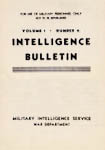 Vol. I, No. 1: September 1942
Vol. I, No. 1: September 1942
CONTENTS: GERMANY: Armored Forces (The 88-mm Gun, Tanks in the Spotlight, Mechanized Warfare) / Air Forces (Focke-Wulf—FW190, Parachutists) / Booby Traps / Land Mines / Training Methods / Night Driving Equipment / Instructions in Case of Capture / 'Secret' Weapon Again? // JAPAN: Ground Forces (Introduction, Tactics, Equipment) / Air Forces / Food
 Vol. I, No. 2: October 1942
Vol. I, No. 2: October 1942
CONTENTS: GERMANY: The Infantry Division / Engineers / Dive-Bombing / Developments in Desert Warfare / Balanced Antitank Protection / Miscellaneous (Use of Dogs, Speed of Vehicles, German-Italian Relations) // JAPAN: Characteristics of the Japanese / Ground Forces / Parachute Forces / New Gas Mask // UNITED NATIONS: Camouflage / Night Combat by Russian Cavalry / "Do's" and "Don'ts" for British Armored Units / How the British Say It / Who They Are
 Vol. I, No. 3: November 1942
Vol. I, No. 3: November 1942
CONTENTS: GERMANY: The Individual Soldier / Reconnaissance Units / Defense Against Aircraft / Fifth Column / German Sub-Stratosphere Planes // JAPAN: The Burma Campaign / The Solomon Islands Campaign / Jungle Warfare / Night Operations / Miscellaneous // ITALY: Weapons Most Frequently Used / Radio Transmission // UNITED NATIONS: Camouflage / Russian Use of the Antitank Rifle
 Vol. I, No. 4: December 1942
Vol. I, No. 4: December 1942
CONTENTS: JAPAN: Fighting in the Solomon Islands / Obstacles / Report by British Prisoners / Tankette (Light Tank) // GERMANY: Hints for Soldiers in Libya / Notes from the North African Theater / Operating the Mark IV Tank / The Junkers (Ju) 88 / Prisoners of War / Miscellaneous (Use of Tanks, Treatment for Blister Gas) // ITALY: The Individual Soldier / Flame Throwers // UNITED NATIONS: Maintaining Direction / Small Arms Antiaircraft Fire / Dust
 Vol. I, No. 5: January 1943
Vol. I, No. 5: January 1943
CONTENTS: GERMANY: Infantry Tactics / Minefields in Desert Terrain / Use of Smoke /50-mm Light Mortar / Security in the Field // JAPAN: Jap Estimate of U.S. Land Tactics / Notes on Recent Fighting in the Southwest Pacific / The Individual Soldier / Service Rifle // ITALY:81-mm Mortar / Torpedo Bomber // UNITED NATIONS: The Moroccan Soldier / British Training and Use of Dogs / Russian Antitank Tactics / Notes on British Antitank Tactics / British Indoor War Game
 Vol. I, No. 6: February 1943
Vol. I, No. 6: February 1943
CONTENTS: JAPAN: Documents Dealing with Japanese Warfare / Extracts from Diaries / Comment by Prisoners // GERMANY:50-mm Antitank Gun / Use of20-mm AA/AT Gun Against Ground Targets / Attacks on Concrete Fortifications / Armored Force Tactics in the Middle East / Winter Flying Problems / Miscellaneous (Field Patching of Armored Troop Carriers, Map Signs for Obstacles) // UNITED NATIONS: How to Use Your Eyes at Night / British Training Notes / How to Use Trousers as a Life Preserver / How New Zealand Troops Penetrate Wire Obstacles
 Vol. I, No. 7: March 1943
Vol. I, No. 7: March 1943
CONTENTS: JAPAN: Japanese Impressions of U.S. Warfare / Details of New Rifle Used by Japanese / Japanese Warfare—From Their Documents / Communications / Japanese Warfare as Seen by U.S. Combatants // GERMANY: Gas Warfare / Visual Signals Between Air and Ground Forces / Infantry Fieldworks / Interrogation of British Prisoners of War / Air Forces / Miscellaneous (Light Assault Bridge, Use of Smoke Against Tanks) // UNITED NATIONS: Notes on Security From the Middle East / British Training For Special Duties / Miscellaneous (Steel Helmets and Head Wounds, British Nicknames of Tanks)
 Vol. I, No. 8: April 1943
Vol. I, No. 8: April 1943
CONTENTS: GERMANY: German Combat in Woods / Recent Developments in German Tactics / German Air Forces / German Gun-Howitzer (Standard 105 mm) / German Tank Maintenance and Recovery / Miscellaneous // JAPAN: Amphibious Tactics Based on Experiences at Wake / Notes on the Japanese—From Their Documents / Japanese Flame Throwers / How the Japanese Treat Natives in S.W. Pacific / Japanese Explanation of S.W. Pacific Reverses / Japanese A/A Guns
 Vol. I, No. 9: May 1943
Vol. I, No. 9: May 1943
CONTENTS: JAPAN: Japanese Warfare as Seen by U.S. Observers / Grenade Dischargers / Japanese Equipment / Information Obtained from Japanese Prisoners // GERMANY: Reconnaissance by Light Tank Platoons / Company Orders (Defense) / Defense Against Ground-Attack Planes / Parachute Troops / Panzer Grenadiers / Antitank and Tank Guns / Miscellaneous (88-mm AA/AT Gun Dug-In, New Machine Gun, Tank Recognition, Flame-throwing Tank) // UNITED NATIONS: Some Health Rules for N. Africa—Middle East / Physical Training Notes for British AA Units
 Vol. I, No. 10: June 1943*
Vol. I, No. 10: June 1943*
CONTENTS: GERMANY: Recent Trends in the Use of Mines and Booby Traps / Artillery Tactics / New German Heavy Tank / Air Force / Miscellaneous // JAPAN: Japanese Use of Smoke / Notes on Boats and Ships in Amphibious Operations / Some Japanese Tactics Observed in Burma / Japanese Tactics at Milne Bay / Notes on the Japanese—From Their Documents / Miscellaneous // UNITED NATIONS: Notes on Light AA (New Zealand) / British Army Notes on Embarkation Security
 Vol. I, No. 11: July 1943
Vol. I, No. 11: July 1943
CONTENTS: GERMANY: Methods of Employing Tanks with Infantry / Combat in High Mountains, Snow, and Extreme Cold / Antitank Tactics as Seen by U.S. Combat Personnel /75-mm Assault Artillery / New75-mm Antitank Gun / Tactics Used byPz. Kw. 4's (With Short75-mm Gun) / Miscellaneous (Methods of Obstructing Airdromes, Delaying Tactics Tripolitania, "Ten Commandments" for Using Tanks) // JAPAN: Japanese Prisoners / Noncom Tells Experiences in New Guinea Fighting / Japanese Warfare as Seen by U.S. Observers / Notes on the Japanese—From Their Documents // UNITED NATIONS: How to Handle Wounded in Difficult Situations / Some British Trends in Combat Firing
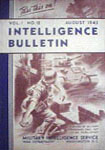 Vol. I, No. 12: August 1943
Vol. I, No. 12: August 1943
CONTENTS: GERMANY: U.S. Wounded Discuss Axis Mines and Booby Traps / Tellermines,"S" Mines , and Notes on Their Use / Tank Hunting / Engineer Assault Tactics / Miscellaneous (Instructions in Case of Capture, Prisoners' Ruse, Use of Roving Guns) // ITALY: B2, S.C.G. AT Mine and B4 Antipersonnel Mine / Notes on Attack // JAPAN: American Wounded Tell About Japanese on Attu / Notes on How Japanese Attack Pillboxes / Defense Techniques / Notes on Japanese Security Measures // UNITED NATIONS: How British Deal With Road Craters, Obstacles / British Junior Officer Tells Combat Experiences / Description of British Antipersonnel Switch // Index for Vol. I, Nos. 1-12
Volume II: September 1943-August 1944
-
 Vol. II, No. 1: September 1943
Vol. II, No. 1: September 1943
CONTENTS: JAPAN: Land Mines, Grenades, and Booby Traps / New Japanese Weapons for Infantry Squad /Type 98 AA/AT Gun / Japanese Comment on U.S. Resistance in Philippines / Comments on Japanese by British Soldiers // GERMANY: German Rules for Use of Contamination Batteries / Some Basic Principles of Coastal Defense / Barbed-Wire Obstacles / Types of Concrete Antitank Obstacles / Reconnaissance Methods / Further Information about German Tanks / Miscellaneous (Directive for Defense of Positions, Basic Infantry Tactics, Tank Ruse to Deceive Artillery, Handling of Prisoners, "This Must Not Occur Again", Railroad Patrol Car (Armored), "We Cannot Lose", Rules for Laying Tellermines, Note on Captured Mines, Device for Stranded Flyers) // UNITED NATIONS: Living in the Jungle / British Use of Tanks in Jungle Warfare
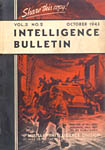 Vol. II, No. 2: October 1943*
Vol. II, No. 2: October 1943*
CONTENTS: GERMANY: New Self-Propelled Gun / Notes on Winter Use of Infantry Weapons / Improvement of Defensive Positions / Road Discipline; Action by All Arms vs. Planes / Street Fighting by Panzer Grenadiers / The Germans in Combat—As Seen by the British / Miscellaneous // JAPAN: Combined Attu Reports on Japanese Warfare / Notes on the Japanese—From Their Documents / Notes by U.S. Observers on Japanese Warfare / Enemy Combat Notes on Use of MGs, AT Rifles / Souvenir Hunters Cause Needless Loss of Lives
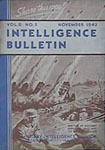 Vol. II, No. 3: November 1943*
Vol. II, No. 3: November 1943*
CONTENTS: GERMANY: German Soldier Describes Terror of Sicily Retreat / Six-Barrel Rocket Weapon (The "Nebelwerfer 41") / Principles of Defense Against Airborne Troops / Weaknesses of Artillery Defensive Positions / Tactical Employment of Flak in the Field / Miscellaneous (Improvised Bangalore Torpedoes, New Army Cap) // JAPAN: New Japanese Weapons / Notes on Japanese Landing Operations / Antiaircraft Measures / Some Defense Techniques Used by the Japanese / Morale, Characteristics of Japanese Soldier // UNITED NATIONS: Some Health Rules For Far East Areas / How to Protect Your Feet // ANNEX: How to Identify War Gases
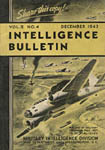 Vol. II, No. 4: December 1943
Vol. II, No. 4: December 1943
CONTENTS: JAPAN: Defense Against Airborne Forces / Notes on Air Tactics Used by Japanese / How Japanese Raiders Demolish Artillery / Japanese Defense Notes / Supplementary Notes on Booby Traps and Mines / Japanese Sentries // GERMANY: German Machine Guns and Notes on Their Use / U.S. Soldiers Discuss German MG Tactics / Use of Infantry Weapons Against Parachutists / Use of Tanks with Infantry / Miscellaneous // UNITED NATIONS: Security First / How U.S. Artillery Terms Differ From British / A Castaway's Diary
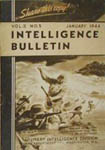 Vol. II, No. 5: January 1944
Vol. II, No. 5: January 1944
CONTENTS: GERMANY: How the German Army Uses Smoke in Combat / How Infantry Battalions Develop for the Attack / Camouflage Against Ground Observers / New Heavy Tank: The Pz. Kw. 5 (Panther) / British Comments on German Use of Tanks / German Combat Tactics in Towns and Cities / German Stake Mine // JAPAN: Enemy Bayonet Technique / Small-Unit Tactics Used by Japanese at Night / Comments by Observers on Fighting in Burma / "Three Jeers for the Souvenir Sap" // UNITED NATIONS: The Infantry Lieutenant and His Platoon / Notes on Patrolling in Jungles of Burma
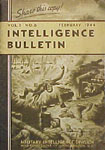 Vol. II, No. 6: February 1944
Vol. II, No. 6: February 1944
CONTENTS: JAPAN: Notes on Japanese Jungle Defense (Introduction, Tactics, Positions, Obstacles) // GERMANY: Von Arnim Discusses Junior Leadership / Camouflage in Sicily / Concentrating the Fire of 81-mm Mortars / Close-Quarter Fighting and Withdrawal / Notes on German Antitank Tactics / Training in a Parachute Machine-Gun Battalion // UNITED NATIONS: The Unseen War
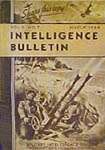 Vol. II, No. 7: March 1944*
Vol. II, No. 7: March 1944*
CONTENTS: JAPAN: Defense of Betio Island / How Japanese Defended Hilly Jungle Country / Molotov Cocktail Employing a Fuze / Intelligence Notes / Camouflage Notes // GERMANY: Military Leadership, as the Germans See It / A Prepared Defensive Position in Italy / A German Company in the Defense / Some Notes on German Mountain Warfare / German Close-Order Drill / More German Obstacles
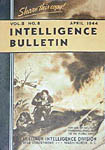 Vol. II, No. 8: April 1944
Vol. II, No. 8: April 1944
CONTENTS: GERMANY: Recent Tactics and Ruses in Mountainous Terrain / Camouflage Against Air Observers / German Prisoners Discuss the Pz. Kw. 6 / Portable Flame Throwers / Notes on German Vehicle Markings / Training Principles of the German Army // JAPAN: Japanese Jungle Warfare / Notes on Developments in Japanese Defense / Two Booby Traps Devised by the Japanese / Japanese Characteristics and Reaction in Battle / Japanese Plan to Counter Superior Fire Power / Some Jap Methods of Overcoming Obstacles / Miscellaneous
 Vol. II, No. 9: May 1944
Vol. II, No. 9: May 1944
CONTENTS: JAPAN: Japanese Positions in the Defense / Japanese Defensive Tactics / How a Fiji Patrol Got 47 Japs Without Loss / Supplementary Notes on Enemy Booby Traps / Japanese Night Attacks / How the Japanese Mark Trails for Night Use / Supplementary Notes on Japanese Camouflage / Some Japanese Ruses / Japanese Explanation of "Duty" and "Spirit" / Japanese Army Rations // GERMANY: German Field Defenses Observed in Italy / Commanders, Observers Discuss Enemy Tactics / German Mine Warfare and Booby Traps (Italy) / German Soldier Tells of the Battle for Agira / Organization of German Tank-Hunting Detachments / German Efforts to Break United Nations Security / German Views on Use of the MG 42 / German Trip-Wire Alarm / Stick Grenade, Model 24, As a Defensive Weapon
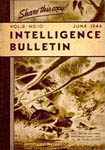 Vol. II, No. 10: June 1944
Vol. II, No. 10: June 1944
CONTENTS: GERMANY: U.S. Soldiers Describe Enemy Methods in Italy / Ground Tactics of German Paratroops / How Paratroops Clear Fields for Gliders / New German Rifle for Paratroopers / Rations as a Factor in Paratroop Efficiency / A German's Reaction to a British Night Attack / German Tank Platoons Operating as Points / New German Emphasis on Salvaging Matériel / Some Notes on German Intelligence Methods / German Multipurpose Carbide Lantern // JAPAN: Japanese Tank Tactics / Japanese Antiaircraft and Coastal Defenses / Two AA/AT Positions / How a Combat Patrol Captured Two Japanese / Japanese Intelligence and Security Measures / Improvised Land Mine Used by Japanese / Japanese Hints for the Individual Soldier / Morale, Characteristics of Japanese Soldiers // UNITED NATIONS: Souvenir Hunting is Still a Problem / Security Notes
 Vol. II, No. 11: July 1944
Vol. II, No. 11: July 1944
CONTENTS: GERMANY: How the Enemy Defended the Town of Ortona / A German Defense Area on the Anzio Front / Flame-ThrowingPz. Kw. 3 / More Notes on Mines and Booby Traps / Booby-Trap Igniters / Combat Smoke Screens Recently Used in Italy / Warning Markers for Contaminated Areas / German Mobile Steel Pillbox / Ruses for Concealing Artillery Positions / Remote-Controlled Demolition Vehicles // JAPAN: Japanese Plan to Counter Hostile Landing Operations / Notes on Japanese Defensive Positions / Japanese Firing Device for Booby Traps or Mines / Some Data on Enemy Mines and Obstacles / Small-Unit Tactics Used by Japanese / Japanese Warfare in Burma // UNITED NATIONS: Facts About Blast, and Shock Waves in Water / Notes on Camouflage and Concealment / G.I. Questions and Answers about Malaria
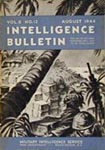 Vol. II, No. 12: August 1944*
Vol. II, No. 12: August 1944*
CONTENTS: JAPAN: Reconnaissance Methods / Problems of Defending the Admiralty Islands / Two Bridge Demolitions in Burma / Japanese March Plan for a Night Withdrawal / Ruses on Kwajalein / Prefabricated Booby Trap / New Wire-Cutting Technique // GERMANY: Tactics of Individual German Arms in Italy / Some Fortifications Observed in Italy / Smoke-Shell Tactics Used by German Tanks / Defense Measures for the Anzio Perimeter / Antivehicle Wooden-Box Mines / Rifle Grenades and Grenade Launchers // UNITED NATIONS: The British Discuss Combat in Towns // Index for Vol. II, Nos. 1-12
Volume III: September 1944-August 1945
-
 Vol. III, No. 1: September 1944
Vol. III, No. 1: September 1944
CONTENTS: JAPAN: Defense Plans for Eniwetok Atoll / U.S. Enlisted Men Discuss the Japanese Soldier / Use of Antitank Mines in the Arakan / A Gun That Sat on a Burma Bottleneck / Sniper Training / Japanese Landing Craft Most Frequently Encountered / New Japanese Uniforms / In Brief // GERMANY: Two Antipersonnel Mines / German Auxiliary Troops / In Brief
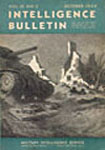 Vol. III, No. 2: October 1944*
Vol. III, No. 2: October 1944*
CONTENTS: GERMANY: U.S. Enlisted Men Discuss Enemy Tactics in France / German Patrol Methods in Italy / German Forward Positions in Defense / Tank Talk / Recent Use of Mines in France and Italy // JAPAN: A General Review of Japanese Weapons / Defenses of Cape Torokina / Captured Japanese Rations May be Eaten // UNITED NATIONS: Patrolling in the Arakan / Bamboo Spike Jungle Traps
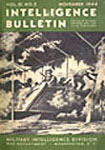 Vol. III, No. 3: November 1944*
Vol. III, No. 3: November 1944*
CONTENTS: JAPAN: Ambush Works Both Ways / How We Fight — Mixed Jap Opinions / How the Japs Concealed Barge-Unloading Points / In the Admiralties — Fanatic Jap Rushes Withered by Steady U.S. Defense / Japanese Cave Defenses on Biak Island / "Home-Made" Offshore Obstacles / Diversionary Units / In Brief // GERMANY: German Antitank Weapons / Fougasse Flame Throwers / Tactics of Personnel Carriers Mounting Flame Throwers / Withdrawal Tactics in Italy / In Brief
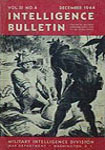 Vol. III, No. 4: December 1944
Vol. III, No. 4: December 1944
CONTENTS: JAPAN: New Pottery Land Mine Introduced on Leyte Island / Japanese Minefield Tactics in the Southwest Pacific / They Learned by Experience / Japanese Officers Hold a Critique / More Notes on Field Fortifications / Model 100 Grenade Launcher Produced in Two Types / In Brief // GERMANY: What Jerry Thinks of Us—and Himself / G.I. Comments on German Use of Fire Power / The S-Mine 44 and Its Igniter / A Tank-Infantry Team Observed in Combat / German Light Amphibious Car / German Assault Artillery / In Brief
COVER: Japanese troops laying hemisphere mines along a jungle road.
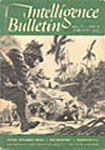 Vol. III, No. 5: January 1945*
Vol. III, No. 5: January 1945*
CONTENTS: JAPAN: The Japanese G.I. / Tank Hunters / Japanese Combat Tactics / The Imperial Rescript / Explosive Bullets / 50-mm Smoke Grenade / Beach Mines // GERMANY: Pillbox Warfare in the Siegfried Line / A Battalion Commander Looks Us Over / The New 88 and Its Carriages / Notes on Tiger Tanks in the Battle for Florence / How the Germans Fight in Wooded and Broken Terrain / Deception, German-Style // UNITED NATIONS: Patrolling on Guam / How to Help the Enemy
COVER: A Japanese antitank assault team attacking a Sherman tank along a jungle road.
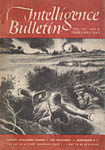 Vol. III, No. 6: February 1945*
Vol. III, No. 6: February 1945*
CONTENTS: GERMANY: Fortress Battalions and How They Are Used / More Notes on Antitank Tactics / Discovered in Combat / Rounding Up the Booby Traps / The German Volkssturm / In Brief // JAPAN: Japanese Diversionary Tactics / The 150-mm Mortar / Enemy Mines on Leyte / Remote-Control Mines in Antitank Warfare / Portable Flame Throwers / New Japanese Army Insignia // UNITED NATIONS: British Raid in Burma / Ordnance Intelligence Teams Uncover Technical Secrets // Index to Volume III,Nos. 1-6
COVER: German bazooka teams in action against U.S. tanks.
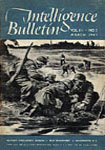 Vol. III, No. 7: March 1945
Vol. III, No. 7: March 1945
CONTENTS: GERMANY: Germany's Rocket and Recoilless Weapons / PW Interrogation: The Germans Mean Business / Mines in the Spotlight / How to Throw the Panzerwurfmine / In Brief // JAPAN: Leyte Veterans Talk About Japs / Mines and Booby Traps on the Burma Road / New Weapons For Jap Tank Hunters / New Weapons Captured at Ormoc / Is He Jap or Chinese?
COVER: German troops laying the antipersonnel Glasmine.
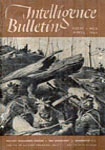 Vol III, No. 8: April 1945
Vol III, No. 8: April 1945
CONTENTS: JAPAN: Breakneck Ridge—A Lesson in Jap Defensive Tactics / A Short History of Japanese Military Rifles / A Jap Report on U.S. Tactics / Japanese Development of Rocket Weapons / More Notes on Booby Traps and Firing Devices // GERMANY: Recent Minefield Doctrine / The Eismine and Other Mine Developments / Patrolling from Static Positions / Discovered in Combat—II / What the Germans Learned at Warsaw / In Brief
COVER: A Jap machine gun emplacement on the flank of a reverse-slope positon prepares to fire at American troops advancing against Breakneck Ridge during operations on Leyte.
 Vol III, No. 9: May 1945*
Vol III, No. 9: May 1945*
CONTENTS: JAPAN: Japanese Withdrawal Tactics in Central Burma / Iwo Jima / The Bamban Hills—A Prepared Defense of Rough Terrain / TNT—A Preliminary Report on Jap Demolitions in Manila / Shoot 'Em Back / In Brief // GERMANY: "The Heavy Mobile Punch" / Allied Combat Efficiency as the Germans See It / Remote-Controlled Machine Gun for Assault Guns and Tank Destroyers / Discovered in Combat—III / Note on the Schumine / New Trip Devices for Local Defense / The Panzerhandmine 3—A Magnetic Hollow Charge // UNITED NATIONS: The Red Soldier
COVER: The Japanese haul a disassembled 20-mm gun up a hillside to a cave position in the Bamban River area.
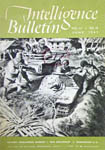 Vol III, No. 10: June 1945*
Vol III, No. 10: June 1945*
CONTENTS: JAPAN: Jap Defense of a Town—Tanks Join the Banzai Charge / "The Officers are Getting Knocked Off" / Japanese Field Artillery Methods / Minefield Patterns in the Defense of Iwo Jima / Kempei—The Japanese Military Police / Close Combat with Tanks / The New Juki / In Brief // GERMANY: "Why We Lost"—A Post Mortem of a German Commander / Tactics of a German Patrol / Concrete Stick Hand Grenade / In Brief // UNITED NATIONS: Soviet Infiltration Units in Mountain Warfare
COVER: Japanese tanks used in the defense of San Manuel, Luzon, were moved in and out of prepared revetments, where they could be employed as pillboxes.
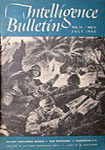 Vol III, No. 11: July 1945
Vol III, No. 11: July 1945
The "Human" AT Mine / Combat Methods of Small Raiding Parties / Combat Lessons from Okinawa / Tombstone Hill / The Most Effective Jap Tank / How to Fight Americans—A Jap Commander's Pep Talk / Jap Weather / Japs' Booby-Trap Ammunition Dumps / Iwo Jima Was Ready—Japanese Plans for Defense / Lost in the Burma Jungle / A Jap Platoon Raid on a Battery Position / Smoke in the Attack / Japanese Counterlandings / New Notes on8-mm Submachine Guns
COVER: A Japanese raiding party, having knocked out an outpost, prepares to open fire on a U.S. command post.
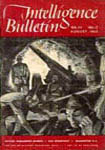 Vol III, No. 12: August 1945
Vol III, No. 12: August 1945
CONTENTS: Latest Tactical Ideas / Jap Defenses in Batangas / Artillery on Okinawa / Jap Commando Units / Jap Walkie-Talkie / City and Town Defense / Okinawa and Iwo Defenders Well Fed and Equipped / The Jap Holes In / Jap Air Tactics at Okinawa / Jap Weather for September / Tank Warfare on Luzon / Armored Communications / Jap Railway Procedures / New Japanese Vehicles / Burma Pillboxes / Demolitions and Obstacles / Technical Notes / Small Island Minefields / Index to Volume III, Nos.7-12
Later Editions
-
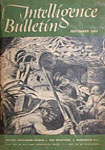 September 1945*
September 1945*
CONTENTS: Souvenirs / Morale and Security / Tactics / Jap Weather for October / Mines and Grenades / Armour (U.S. Forces Encounter Old Jap Tankette; Jap Flame Tank) / Weapons / Miscellaneous
COVER: Japanese troops, assigned the defense of a critical beach area, move into a pillbox to engage an invading force. During the pre-invasion bombardment these troops took cover in previously prepared personnel shelters.
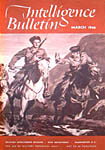 March 1946
March 1946
CONTENTS: Preparedness in the Atomic Age / The "Little Man"—Jap Undercover Intelligence in Japan / Red Army Officers' Corps / Von Rundstedt Explains—Reasons for Germany's Defeat / Operation Easter Egg—German Plan for Sabotage Depots / Japanese Intelligence Methods—Part I: The Intelligence Organization of Japan / German Horse Cavalry and Transport / The Plan That Failed—Japan's Ground Strategy from Pearl Harbor to Defeat / The German Mouse: Super-Super-Super-Heavy Tank Became Hitler's White Elephant / Japanese Military Medicine / What Do You Know About Foreign Weapons? / Red Army Guards
COVER: Lightly armed Cossack cavalry, impressed into German service, was a valuable asset in policing mountainous Balkan terrain. This German-controlled cavalry represented only a small percentage of the total number of horse and horse-drawn units which, together with pack units, made up most of the "highly-mechanized" German Army.
 April 1946
April 1946
CONTENTS: Guided Missiles—The Weapon of the Future / Compulsory Military Training in the U.S.S.R. / Defense by Flame / German Combustible Cartridge Cases / Credit—Where It's Due / Black Dragon / German Induction Mine Detonator / Hasty Minefields—Russian Style /AMT VI D 4 —A Story of Nazi Espionage / Incendiary Rifle Grenade / Oberlt. Oster Reports / Japanese Intelligence Methods—Part 2: Undercover Intelligence
COVER: One of the big German war boners was their failure to coordinate their aggressive plans with their development of guided missiles. Had this program, in which the Germans held the lead, been pushed to real fruition, the results would have been incalculable. Guided flak missiles, like the Rheintochter model here shown under German test, might have driven Allied planes from the air over Germany. The story of German guided missiles and the light they throw on future weapons of this type begins on page 1.
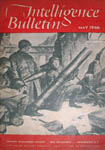 May 1946
May 1946
CONTENTS: "BW"—An Analysis of Biological Warfare as a Weapon / "On the Way!"—The Employment of Mortars in the Red Army / Noise That Kills / Under the Star and Crescent—The Turkish Army / The Electric Gun—German Experiment with Electrically Launched Projectile / Cavalry in Mass—Soviet Doctrine for the Employment of Horse-Mounted Troops / The Jap Army Goes to Sea / "Geronimo!" and the Red Army / Going to Japan?—What the Japanese Think of Us / Tokarev M1940—Fluted Chamber Aids Cartridge Extraction
COVER: Gunners of a Red Army heavy mortar unit put their guns into battery during the siege of Stalingrad. There are seven 120-mm mortars of this type in the heavy mortar battery of a Red Army rifle regiment. These guns, with the medium and light mortar units of the regiment, give the Soviet infantryman two and one-half times the mortar support found in the U.S. infantry regiment. Support fire from these weapons in the Red Army is delivered by using artillery methods; the outstanding characteristic being the use of massed fire.
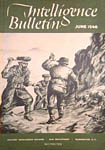 June 1946
June 1946
CONTENTS: Moroccan Goums / Soviet Tanks in City Fighting / Sweden Turns to Jets / The Red Army Infantryman / Alamo Scouts / The German "Kamikazes" / Soviet Hand Grenades / Name, Rank, Serial Number—Plus! / Punishment by Example
COVER: On the night of28-29 July 1943, the 4th Tabor, a unit of Goumiers attached to the U.S. 1st Infantry Division, received orders to occupy an enemy-held mountain. The attack up the mountain was a particularly bloody one, made in the face of severe German machine gun and mortar fire. But in the words of the French after-action report: "The attack was pressed home, and the position stormed. Some of the enemy may have escaped. No prisoners were taken. Mission accomplished."